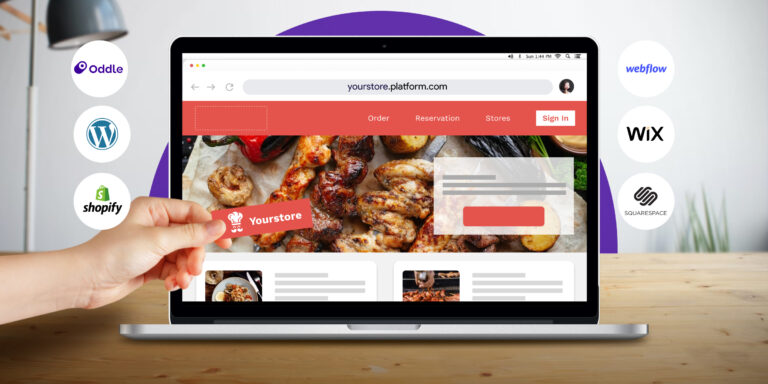Comparing the Best Restaurant Website Platforms
Assessing core features & suitability
Even with the worst of the pandemic behind us, the food delivery market has continued to grow. A report by CNA on shifting consumer preferences has noted that, for many, delivery is a “convenience that [they] can no longer do without”.
But as more and more F&B businesses jump onboard to offer food delivery services, several issues have become apparent. Firstly, most delivery platforms charge sky high commission fees, steadily raising them even through COVID. The industry standard hovers around a hefty 30%, eating away into a restaurant’s already slim margins. Furthermore, a survey of 500 respondents showed that “40 per cent … were more likely to blame the restaurant than the delivery service providers (DSP)” whenever something went wrong.
With all these disadvantages stacked against them, plenty of F&B businesses have taken to managing their own deliveries and ordering systems instead. For many, the change has yielded positive results. If you’re thinking of making the switch, this article compares the best restaurant website platforms available to help you make a decision.
1. WordPress - Versatile Content Management System
While it’s commonly known as a blogging site, WordPress is an open-source content management system that can be modified and customised for a myriad of different uses. Its wide range of features include a library of themes and a built-in SEO feature to help optimise your site. You’ll also find thousands of useful plug-ins like WooCommerce, which can be seamlessly integrated with your restaurant website to accept payments on food delivery & takeaway orders.
However, to download plug-ins and use WooCommerce, users have to subscribe to the site’s paid Business plan. The high-degree of flexibility afforded by WordPress also comes with a steep learning curve, as coding knowledge is required to fully customise the site to your liking.
2. Wix - Intuitive Builder with Customisable Templates
A popular option for beginners, Wix has over 500 templates that can be customised with an easy-to-use drag-and-drop interface. Similar to WordPress, business owners have to be on a paid plan to access their e-commerce features. This includes over 80 payment solutions, analytics tools to monitor site traffic, and a built-in SEO wizard.
While Wix is fairly customisable, users are unable to switch templates once their site is live. Any major changes you might want to make will require you to start from scratch.
3. Oddle e-Shop - Built for F&B Delivery & Takeaways
Easily customisable with a drag-and-drop builder module that requires zero coding experience, Oddle’s white-label platform was built specifically for F&B brands to optimise their delivery and takeaway sales.
As shown in the snippet above, users are able to select their own banners and buttons, switch between an extensive range of fonts, and select a custom domain name to bring out the best their brand’s identity. All e-Shops have been optimised for search engine indexability and mobile viewing, enabling customers to easily discover the e-Shop with a single search.
Users also have access to an all-in-one merchant dashboard that provides a wealth of customer data, from best-selling shop items to the total number of orders a customer has made and their last purchase date. Through such data insights, merchants will be able to lead their own marketing campaigns via email, target lapsed buyers through social ads, and retain their best customers through consistent engagement.
The best part? Unlike most other website builders, the Oddle e-Shop has zero set-up costs and doesn’t require a subscription fee or paid plan to maintain.
4. Shopify - Designed for e-Commerce
As a website builder that’s been designed just for e-commerce, all Shopify plans come with unlimited storage and bandwidth, allowing your digital shop to easily grow with you as your business expands.
User-friendly and functional, most users are able to create a live store in just a few hours, and integrate their store with thousands of other useful apps that extend its functionality. This includes event ticketing apps, discount code apps that generate unique codes for one-time use, and many more. However, most of these apps require additional costs to use. And as Shopify only offers paid plans, with rather pricey transaction fees and an extremely limited number of free themes, users might find that their costs start to add up.
5. Squarespace - Sleek, User-friendly Website Builder
Well-known for their beautiful templates, Squarespace is a multi-purpose, drag-and-drop website builder enjoyed by content creators and business owners alike.
While the site doesn’t offer free plans, all their business plans come with integrated e-commerce features, which allows users to avoid the hassle of installing separate plug-ins. Users can also access add-ons like pop-ups, photo galleries, appointment scheduling tools, and more via the web editor. The site offers its own analytics system, with information such as page views and most popular products. For more comprehensive data, users can connect to their own Google Analytics account.
Most notably, Squarespace comes with a paid email campaigns feature. Users can easily engage their customer database by choosing from a series of stunning email templates.
We have more tips to share! Increase your revenue with this list of Common Sales Problems & Fixes, or learn to Use Data Analytics to boost Restaurant Sales.


